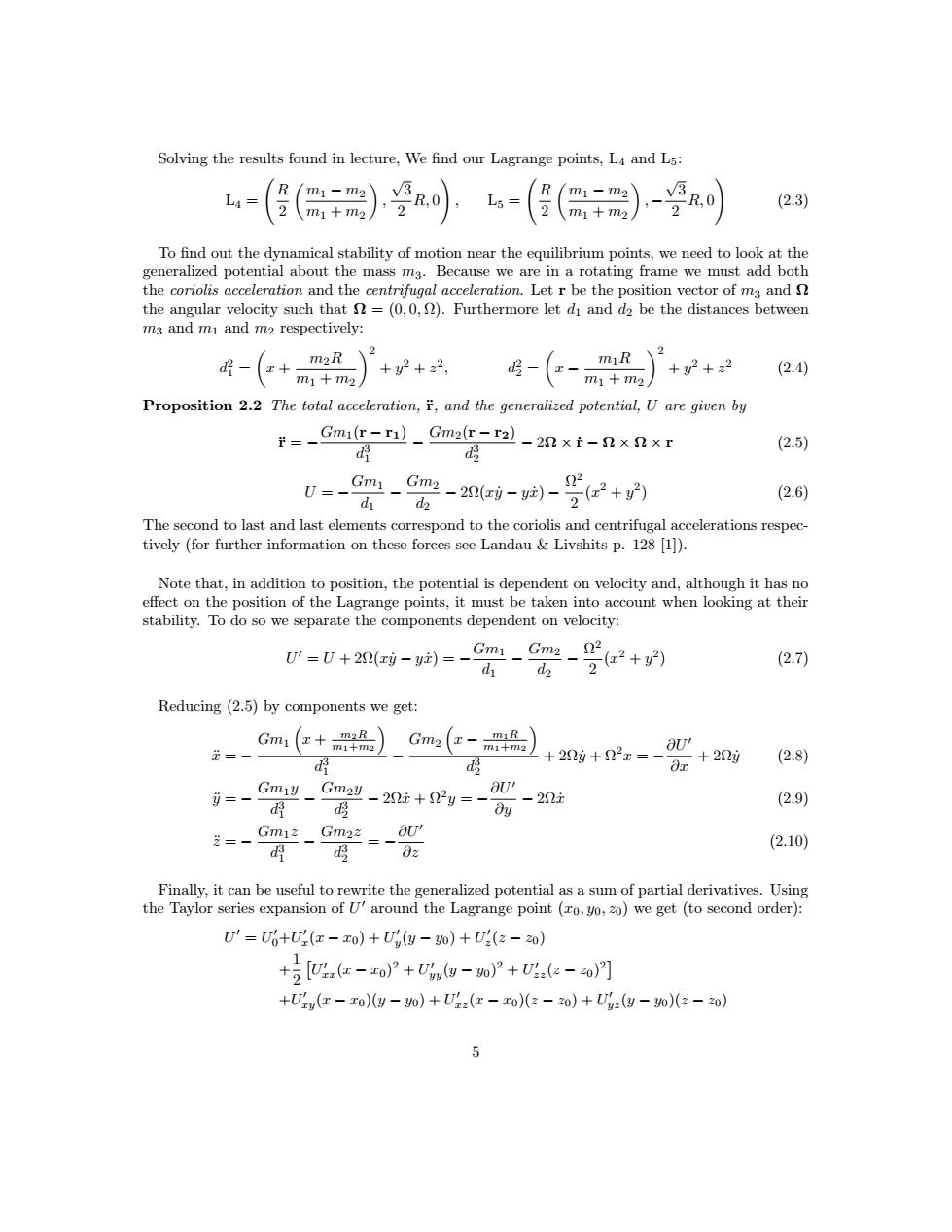正在加载图片...

Solving the results found in lecture,We find our Lagrange points,L4 and Ls: m1-m2 2 Ls= m1-m2 2R0 (2.3) m1+m2 m1+m2 To find out the dynamical stability of motion near the equilibrium points,we need to look at the generalized potential about the mass m3.Because we are in a rotating frame we must add both the coriolis acceleration and the centrifugal acceleration.Let r be the position vector of m3 and n the angular velocity such that =(0,0,)Furthermore let di and d2 be the distances between m3 and mi and m2 respectively: 2 =x+ m2R +y2+22, mR +y2+z2 (2.4) m1+m2 m1+m2 Proposition 2.2 The total acceleration,f,and the generalized potential,U are given by Gm1c-r_Gm2r-r2l-2n×i-×2×r d d (2.5) 0=-Gm1-Gm2-2mx-)-,(2+y) (2.6) d山d2 The second to last and last elements correspond to the coriolis and centrifugal accelerations respec- tively(for further information on these forces see Landau Livshits p.128 [1]). Note that,in addition to position,the potential is dependent on velocity and,although it has no effect on the position of the Lagrange points,it must be taken into account when looking at their stability.To do so we separate the components dependent on velocity: 0'=0+2(y-y)=-Gm-Gm2-2 2 2+y2) (2.7) d d Reducing (2.5)by components we get: Gm(c+品 Gm2(x-m1+m2 mIR +22g+22x= aU' 龙三 的 +22 (2.8) =- Gmy Gmay-20i+2y=- 8U' -22i d ay (2.9) 艺=、 Gm1z Gm22 0U' (2.10) d 8z Finally,it can be useful to rewrite the generalized potential as a sum of partial derivatives.Using the Taylor series expansion of U'around the Lagrange point (ro,y0,z0)we get (to second order): U'=U6+U(x-xo)+Ug(g-0)+U(z-20) +号【.e-oP+U-%P+U.e-2o月 +Uy(x-x0)(g-0)+U2(x-x0)(z-20)+Ug2(y-0)(z-20) 5Solving the results found in lecture, We find our Lagrange points, L4 and L5: L4 = R 2 m1 − m2 m1 + m2 , √ 3 2 R, 0 ! , L5 = R 2 m1 − m2 m1 + m2 , − √ 3 2 R, 0 ! (2.3) To find out the dynamical stability of motion near the equilibrium points, we need to look at the generalized potential about the mass m3. Because we are in a rotating frame we must add both the coriolis acceleration and the centrifugal acceleration. Let r be the position vector of m3 and Ω the angular velocity such that Ω = (0, 0, Ω). Furthermore let d1 and d2 be the distances between m3 and m1 and m2 respectively: d 2 1 = x + m2R m1 + m2 2 + y 2 + z 2 , d2 2 = x − m1R m1 + m2 2 + y 2 + z 2 (2.4) Proposition 2.2 The total acceleration, ¨r, and the generalized potential, U are given by ¨r = − Gm1(r − r1) d 3 1 − Gm2(r − r2) d 3 2 − 2Ω × ˙r − Ω × Ω × r (2.5) U = − Gm1 d1 − Gm2 d2 − 2Ω(xy˙ − yx˙) − Ω 2 2 (x 2 + y 2 ) (2.6) The second to last and last elements correspond to the coriolis and centrifugal accelerations respectively (for further information on these forces see Landau & Livshits p. 128 [1]). Note that, in addition to position, the potential is dependent on velocity and, although it has no effect on the position of the Lagrange points, it must be taken into account when looking at their stability. To do so we separate the components dependent on velocity: U 0 = U + 2Ω(xy˙ − yx˙) = − Gm1 d1 − Gm2 d2 − Ω 2 2 (x 2 + y 2 ) (2.7) Reducing (2.5) by components we get: x¨ = − Gm1 x + m2R m1+m2 d 3 1 − Gm2 x − m1R m1+m2 d 3 2 + 2Ω ˙y + Ω2x = − ∂U0 ∂x + 2Ω ˙y (2.8) y¨ = − Gm1y d 3 1 − Gm2y d 3 2 − 2Ω ˙x + Ω2 y = − ∂U0 ∂y − 2Ω ˙x (2.9) z¨ = − Gm1z d 3 1 − Gm2z d 3 2 = − ∂U0 ∂z (2.10) Finally, it can be useful to rewrite the generalized potential as a sum of partial derivatives. Using the Taylor series expansion of U 0 around the Lagrange point (x0, y0, z0) we get (to second order): U 0 = U 0 0+U 0 x (x − x0) + U 0 y (y − y0) + U 0 z (z − z0) + 1 2 U 0 xx(x − x0) 2 + U 0 yy(y − y0) 2 + U 0 zz(z − z0) 2 +U 0 xy(x − x0)(y − y0) + U 0 xz(x − x0)(z − z0) + U 0 yz(y − y0)(z − z0) 5��